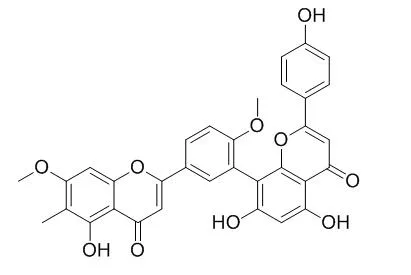| Description: |
Taiwanhomoflavone A is cytotoxic with ED50 values of 3.4, 1.0, 2.0 and 2.5 microg/ml, respectively, against KB epidermoid carcinoma of nasopharynx, COLO-205 colon carcinoma, Hepa-3B hepatoma, and Hela cervix tumor cells. |
| In vitro: |
| Chem Pharm Bull (Tokyo). 2000 Mar;48(3):440-1. | | A novel cytotoxic C-methylated biflavone from the stem of Cephalotaxus wilsoniana.[Pubmed: 10726874] |
METHODS AND RESULTS:
Bioassay-directed fractionation of an ethanolic extract of Cephalotaxus wilsoniana has resulted in the isolation of a novel C-methylated biflavone, Taiwanhomoflavone A (1). Its structure was elucidated on the basis of spectroscopic analysis.
CONCLUSIONS:
Taiwanhomoflavone A is cytotoxic with ED50 values of 3.4, 1.0, 2.0 and 2.5 microg/ml, respectively, against KB epidermoid carcinoma of nasopharynx, COLO-205 colon carcinoma, Hepa-3B hepatoma, and Hela cervix tumor cells. | | Int J Mol Sci. 2007 Aug; 8(8): 830–841. | | Antiplatelet Effect and Selective Binding to Cyclooxygenase (COX) by Molecular Docking Analysis of Flavonoids and Lignans.[Reference: WebLink] | The known flavonoids ginkgetin (1), Taiwanhomoflavone A (2), taiwanhomoflavone B (3), and taiwanhomoflavone C (4) and eight known lignans: justicidin B (9), justicidin C (10), justicidin D (11), chinensinaphthol methyl ether (12), procumphthalide A (13), procumbenoside A (15), and ciliatosides A (16) and B (17) were isolated from Cephalotaxus wilsoniana and Justicia species, respectively.
METHODS AND RESULTS:
The antiplatelet effects of the above constituents on human platelet-rich plasma (PRP) were evaluated. Of the compounds tested on human PRP, compounds 1, 4, 9, and 11 showed inhibition of secondary aggregation induced by adrenaline. Compound 1 had an inhibitory effect on cyclooxygenase-1 (COX-1). Molecular docking studies revealed that 1 and the related compounds apigenin (5), cycloheterophyllin (6), broussoflavone F (7), and quercetin (8) were docked near the gate of active site of COX-1.
CONCLUSIONS:
It indicated that the antiplatelet effect of 1, 4, 9, and 11 is partially owed to suppression of COX-1 activity and reduced thromboxane formation. Flavonoids, 1, 5, 6, 7, and 8 may block the gate of the active site of COX-1 and interfere the conversion of arachidonic acid to prostaglandin (PG) H2 in the COX-1 active site. |
|






 Cell. 2018 Jan 11;172(1-2):249-261.e12. doi: 10.1016/j.cell.2017.12.019.IF=36.216(2019)
Cell. 2018 Jan 11;172(1-2):249-261.e12. doi: 10.1016/j.cell.2017.12.019.IF=36.216(2019) Cell Metab. 2020 Mar 3;31(3):534-548.e5. doi: 10.1016/j.cmet.2020.01.002.IF=22.415(2019)
Cell Metab. 2020 Mar 3;31(3):534-548.e5. doi: 10.1016/j.cmet.2020.01.002.IF=22.415(2019) Mol Cell. 2017 Nov 16;68(4):673-685.e6. doi: 10.1016/j.molcel.2017.10.022.IF=14.548(2019)
Mol Cell. 2017 Nov 16;68(4):673-685.e6. doi: 10.1016/j.molcel.2017.10.022.IF=14.548(2019)